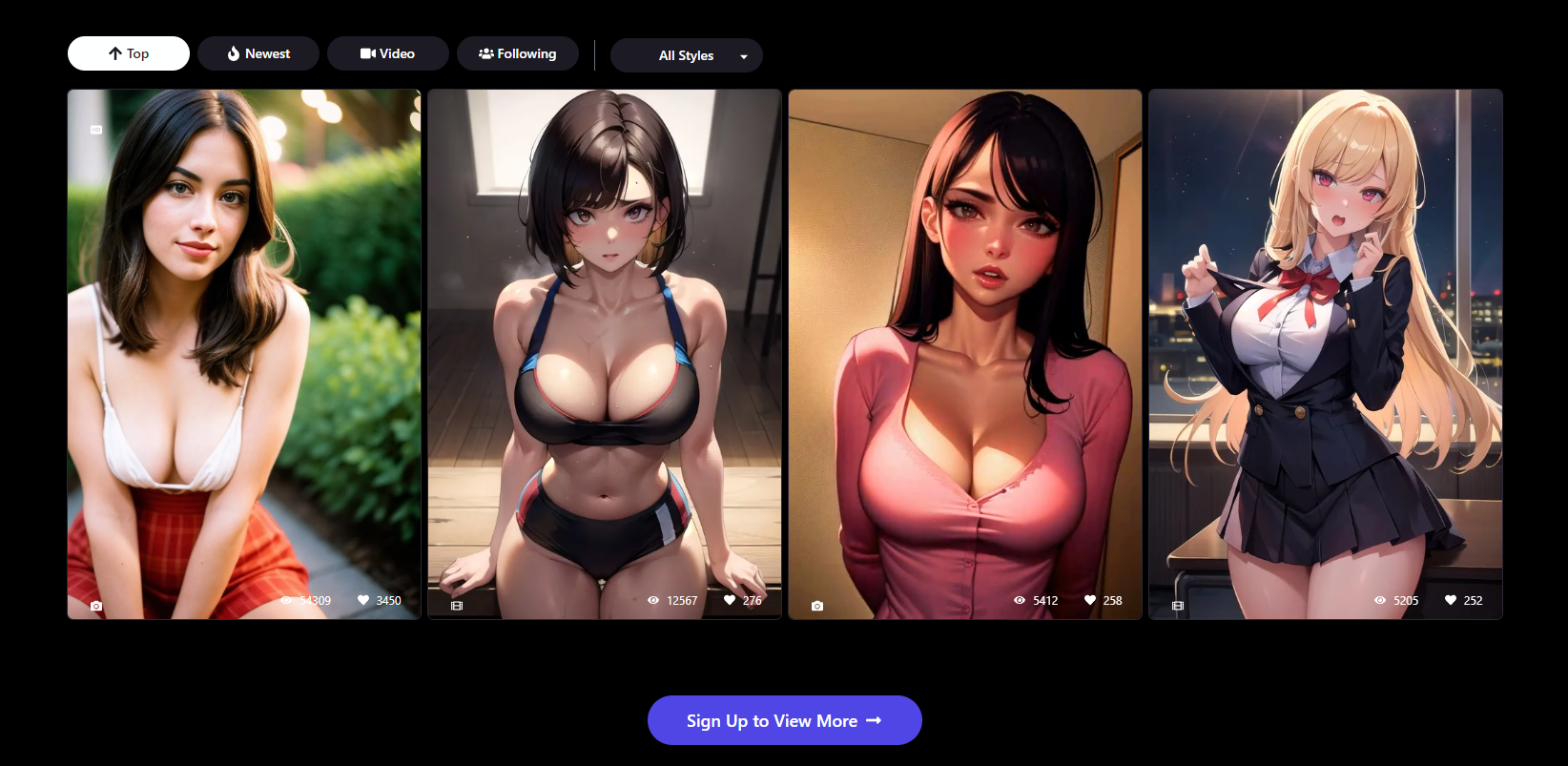Ai Topless Girls vs Real Models: Examining the Impact on the Fashion and Advertising Industries
5th November 2024Before the rise of artificial intelligence (AI), topless girls were a common sight in fashion and advertising campaigns. However, with AI technology advancing rapidly, the use of real models is becoming less prevalent.
This shift has sparked debates about the impact on the fashion and advertising industries. We will delve into the topic of AI topless girls vs real models and examine its effects on these industries.
Examining Candy.ai
Candy.ai has gained notoriety for being one of the first companies to create an AI-generated model. This digital supermodel now boasts millions of followers on social media platforms and has even starred in high-end fashion campaigns alongside real-life models. However, behind all the hype lies both potential advantages and drawbacks.
Pros:
- It eliminates the need for human models, reducing costs for brands and decreasing environmental impact by eliminating travel expenses for photoshoots.
- By using AI models, there is less pressure on real-life models to maintain unrealistic body standards.
- Candy.ai provides a more diverse representation of beauty standards as it can be customized to any desired appearance.
Cons:
- AI models like Candy.ai can perpetuate unattainable beauty ideals as they are still programmed based on societal expectations of attractiveness.
- This technology could potentially lead to job loss among traditional models who rely on modeling as their primary source of income.
The introduction of Candy.ai and other similar technologies raises important questions about inclusivity, diversity, ethics, and sustainability within the fashion industry.

Seduced.ai: The Controversial Virtual Model
Seduced.ai is another AI-generated model that has been making headlines for its controversial campaigns. This digital model has been designed to push boundaries and challenge societal norms through its provocative poses and expressions. Its creators argue that Seduced.ai is a symbol of empowerment for women, breaking free from the constraints of traditional modeling industry standards.
Pros:
- The use of AI models like Seduced.ai allows for greater creative freedom in fashion and advertising, pushing the boundaries of what is considered acceptable or beautiful.
- This virtual model challenges beauty stereotypes and encourages self-love among viewers.
- Seduced.ai promotes body positivity and inclusivity by showcasing various body types, sizes, and ethnicities.
Cons:
- The sexualized nature of Seduced.ai’s campaigns can be seen as objectifying women rather than empowering them.
- There are concerns about the impact on young audiences who may internalize these images and behaviors as desirable or normal.
The discussion around Seduced.ai highlights how technology can simultaneously push boundaries while also raising important ethical considerations.

PromptChan: The Future Face of Fashion?
PromptChan takes things a step further by not only being an AI-generated model but also an AI-designed clothing line. Using advanced algorithms and data analysis, PromptChan creates unique designs based on consumer preferences, trends, and weather patterns. This innovation brings personalized fashion to a whole new level and raises questions about the roles of designers and consumers in the future.
Pros:
- This technology eliminates waste in the fashion industry by only producing clothing that has been ordered, reducing the environmental impact.
- PromptChan provides customers with one-of-a-kind pieces tailored to their individual style and needs.
- With PromptChan, fashion becomes more accessible to a wider audience as it cuts out the middleman and lowers production costs.
Cons:
- PromptChan’s algorithm may reinforce consumerism by encouraging individuals to constantly purchase new pieces based on data-driven trends.
- The use of AI in designing clothes raises concerns about job loss for human designers and potential copyright issues. Now, with the rise of technology, the possibility of creating an artificial intelligence pornstar has become a reality in the adult entertainment industry.
As we continue to embrace technology in all aspects of our lives, PromptChan presents an interesting yet thought-provoking concept of the future of fashion.
The Impact of Ai Topless Girls on Real Models and Society
The rise of AI-generated models like Candy.ai, Seduced.ai, and PromptChan brings up valid questions about their impact on traditional models and society as a whole. Will these virtual models replace real-life ones? What does this mean for body image and beauty standards? While there are no definitive answers, one thing is certain – AI has disrupted the status quo in fashion and advertising industries.
The emergence of Ai topless girls challenges long-standing beauty ideals perpetuated by traditional modeling agencies. With customizable features, these digital models represent a diverse range of appearances that challenge Westernized notions of beauty. This can be seen as a positive step towards inclusivity and representation within the fashion industry. However, some argue that these images are still programmed based on societal expectations and therefore do not truly break away from established norms.
Moreover, the use of AI models raises concerns about job displacement among traditional models who rely on modeling as their primary source of income. With brands opting for cost-effective alternatives like virtual models, there is a risk that many will lose opportunities in an already competitive field. This could lead to financial strain for those in the industry and potentially limit diversity as only those who can afford to pursue modeling as a hobby or side job will prevail.
There are concerns about the impact on society, particularly young audiences, who may internalize these AI-generated images as real and strive for unattainable beauty standards. There is also the issue of sexualization of women through provocative campaigns that objectify them rather than empower them. As AI continues to evolve and become more integrated into our daily lives, it is crucial to consider its potential effects on individuals’ mental well-being and self-esteem.
Candy.ai, Seduced.ai, and PromptChan have sparked conversations about technology’s role in fashion and advertising industries. While they offer innovative solutions and possibilities, their use raises valid ethical concerns. It is up to us as consumers to critically examine and reflect on the implications of these advancements and demand transparency from brands using AI models. It is essential to find a balance between technological progress and responsible practices in order to create a more inclusive and sustainable future for all.

Candy.ai
✔️ Generate AI Porn Images
✔️ Listen To Voice Messages
✔️ Fast Response Time

Seduced.ai
✔️ Generate AI Models
✔️ Save & Reuse Girls
✔️ 300 Images Per Month

PromptChan.ai
✔️ Completely Free To Test
✔️ Edit Your AI Models
✔️ Make Porn Images (no limit)
Can AI technology accurately create topless images of women without their consent?
The accuracy of AI technology in creating topless images of women without their consent is a controversial and complex topic. While some argue that it is possible for AI to generate realistic images, there are concerns about the ethical implications and potential harm towards women’s rights and privacy. Proper regulation and ethical considerations must be in place to ensure the responsible use of this technology.
What steps are being taken to ensure ethical use of AI-generated topless images in media and advertising?
As AI-generated topless images become more prevalent in media and advertising, steps are being taken to ensure ethical use. This includes implementing strict guidelines for the creation and distribution of such images, educating creators on responsible use, and incorporating consent from models or subjects involved. Ongoing discussions surrounding ethics in AI technology are helping to establish best practices for its implementation in this context.
